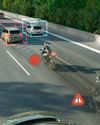In India, the move towards electric mobility has recently been underlined by Niti Aayog’s announcement to go all-electric by 2030. Complementing this initiative is the Faster Adoption and Manufacturing of Electric vehicles (FAME) scheme, which intends to offer significant financial and infrastructure-related incentives to the automobile industry in having an operational eco-system in place for complete electrification.

The FAME India Scheme was implemented from 1st April 2015, with the objective to support hybrid/electric vehicles’ market development and the manufacturing eco-system. The first phase of the scheme, which came to an end last month, has helped with the sale of 45,000 EVs till March 2017. Out of the total units sold, two-wheelers accounted for a sizeable chunk of 40,000 units and the remaining 5,000 units comprised electric cars.
HARNESSING INHERENT POTENTIAL
The auto sector believes that electric mobility has massive potential and is pinning its hopes on early strategic changes in policy, which would push wider adoption of e-mobility. The Union Cabinet intends to take a call on the issue soon and Niti Aayog has estimated that India can save up to 64 % of its energy demand for road transportation and reduce carbon emissions by 37 % by 2030, if it works towards an electric mobility future.
However, the Society of Manufacturers of Electric Vehicles (SMEV) has recently raised concerns regarding confusion over the continuity of the government’s incentives to promote e-vehicles under FAME 1. Commenting on the current predicament, Sohinder Gill, Corporate Director, SMEV, and CEO, Hero Electric, said, “The recent news that the electric vehicle mission has been moved from DHI to NITI Aayog came to us a surprise, and has led to confusion and uncertainty on the fate and the timing of FAME 2.”
Reinstating the industry’s urgent need for clarity, Gill added, “The industry is seeking assurance from the government on continuity in the EV mission and that the tapering or withdrawals of initiatives should be forewarned at least a year in advance, so that the industry can adjust its business plans accordingly.”
This story is from the October 2017 edition of Auto Tech Review.
Start your 7-day Magzter GOLD free trial to access thousands of curated premium stories, and 8,500+ magazines and newspapers.
Already a subscriber ? Sign In
This story is from the October 2017 edition of Auto Tech Review.
Start your 7-day Magzter GOLD free trial to access thousands of curated premium stories, and 8,500+ magazines and newspapers.
Already a subscriber? Sign In

Sound Generation For Enhanced Road Safety
With an ever-increasing number of fully electric and hybrid vehicles entering the market, we are witnessing a change in the acoustic experience in and around the car. The silent nature of the electric powertrain means that other road users miss the familiar acoustic cues that warn them of an approaching vehicle. To remedy this situation, Harman is working on various noise management solutions.

OBJECTIVE ASSESSMENT OF THE SAFETY CONTRIBUTION OF TODAY'S AUTOMOTIVE HEADLAMPS
Good lighting makes a major contribution to road safety. In 2011, the International Commission on Illumination (CIE) presented an evaluation system for headlamps that can objectively assess the quality of illumination and glare limitation. New light sources like LEDs and lighting functions (glare-free high beam, partial high beam) have been available for several years, so that an extension of the proven CIE method is necessary, which takes into account, among other things, changed switch-on and service lives of new lighting functions and represents a generally understandable evaluation system. An evaluation system presented in the following by the Technische Uni versität Darmstadt, which was developed by an encompassing expert commission, is intended to provide representative data and enable an objective evaluation of headlamp performance.

RAPIDO RE-INNOVATES TO CATER TO POST COVID-19 LAST MILE CONNECTIVITY
The rapid pace of urbanisation in the country has witnessed cities expanding and subsuming surrounding villages and smaller towns, evolving into Tier II and III cities.

FUNCTIONAL SAFETY STANDARDS TOP PRIORITY FOR FUTURE AUTOMOTIVE DEPLOYMENT
Increasing levels of electronic content in vehicles result in a large amount of software that is required to run the scenes behind the mechanical aspects of a vehicle. Electronic systems in automobiles are part of every section, from the powertrain to comfort and convenience systems as well as all types of safety equipment. This makes electronics and the software running these systems a critical part of the equation for future mobility solutions. In addition, putting standards in place to measure methods of developing, testing and functioning of such electronic systems also becomes highly relevant.

“BYD'S EV STRATEGY TO ENCOMPASS MOST FORMS OF TRANSPORTATION NEEDS IN INDIA”
The country’s electric vehicle (EV) ecosystem is grappling with a plethora of challenges even as it is striving to wriggle itself out of the ‘nascent stage’ tag. In an exclusive chat with Auto Tech Review, Zhang Jie Ketsu, Executive Director, BYD India shares his perspective on the current EV scenario and how the company intends to progress faster in the Indian automotive industry

SAFETY IN ELECTRIC AND AUTONOMOUS CARS – SIMULATION OF COMPLEX CRASH SCENARIOS
Electric and autonomous vehicles allow for novel seating arrangements and packaging strategies, presenting new safety challenges. Physical crash testing must be supplemented with virtual simulation to ensure vehicle safety on shorter development cycles. With its Simcenter Madymo MBS software, Siemens provides improved runtimes and the Active Human model, enabling accurate and rapid occupant safety analysis in complex crash scenarios.

KIA SONET – A MIGHTY OFFERING IN THE COMPACT SUV SEGMENT
It wouldn't be wrong to say that Kia Motors India has taken the Indian market by storm in less than 12 months of its presence in the market.

NISSAN'S NEW DIRECTION: ARIYA ALL-ELECTRIC
Marking a key milestone in Nissan’s transformation strategy, Ariya ticks a lot of boxes highlighting the strengths of the global automotive giant.

BETTER SAFETY WITH EMERGENCY BRAKE ASSIST FOR MOTORCYCLES
Rear-end collisions with a slower vehicle suddenly cutting into the lane and intersection accidents with cross-traffic are among the most frequent motorcycle accident types. Continental is now developing an emergency brake assist, which detects an imminent collision with a vehicle ahead or with an obstacle, warns the rider and supports him during braking

ADAS WILL SERVE AS CATALYST FOR IMPROVED VEHICLE SAFETY
The automotive industry across the globe is increasingly focussing on safety.